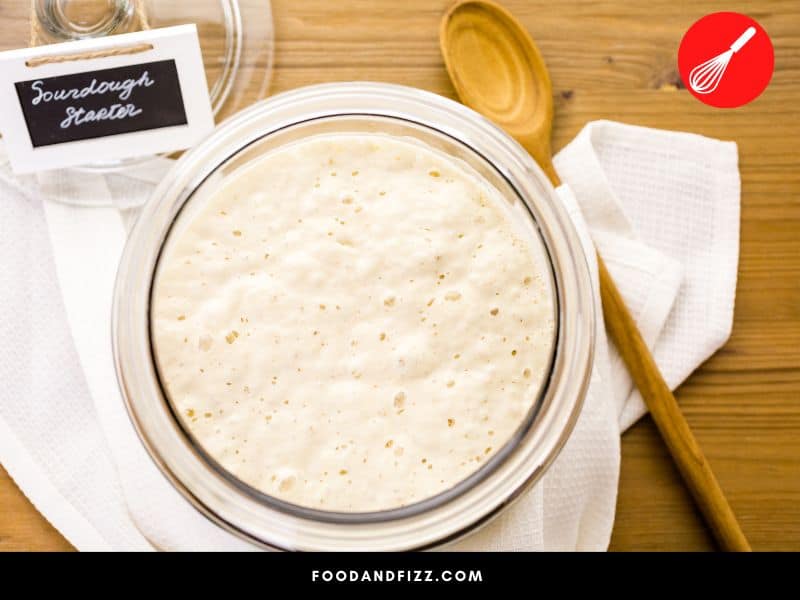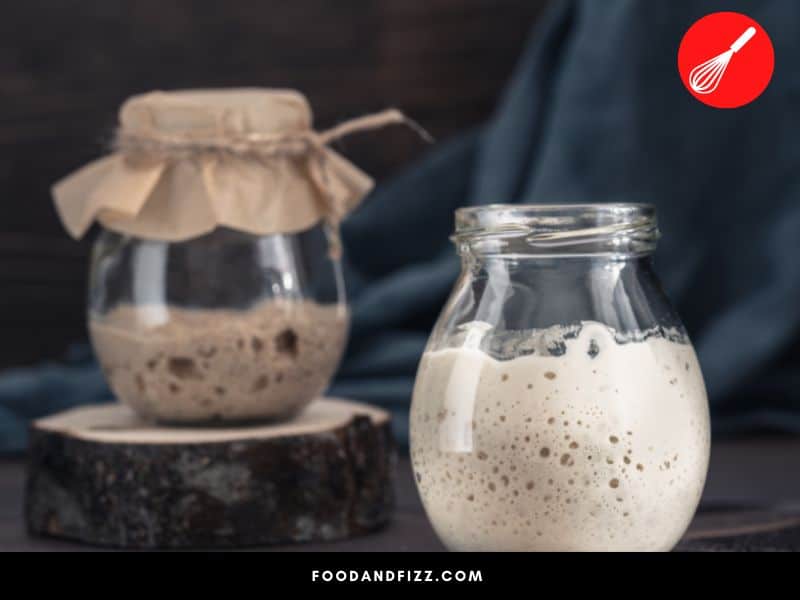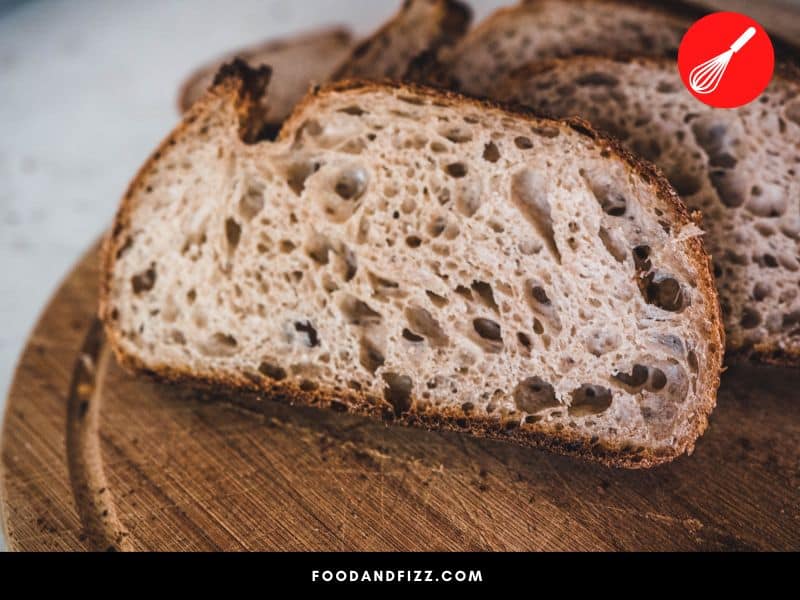Sourdough Smells like Acetone?
When you dabble in home fermentation, it becomes a normal occurrence to ask strange questions. Questions like, why do I smell gym socks or baby vomit in this bottle of sourdough starter? Or why does my ginger bug smell like vinegar?
Questions that may seem odd to the person who’s never fermented anything in their kitchen, but will be met with a nod of understanding from those that have been in the same boat.
Sourdough is one of those baffling things that have sparked long conversations in fermenting circles. Because sourdough starters are all unique depending on geographical location, flour, water, ambient environment, and the person making it, all sorts of questions can arise when you start to make your own.
Guides exist to steer you in the right direction but ultimately, fermenting is more of an art than an exact science, and it takes a little bit of intuition and observation too to know the behavior of your specific starter.
One of the odd things that sourdough can smell like is acetone or nail polish remover. What causes this to happen?
Why Does Sourdough Smell Like Acetone?
An underfed starter is usually the culprit when your sourdough bread smells of acetone or nail polish remover. A sourdough starter should smell pleasantly yeasty, with a slightly sour smell. A smell that reminds you of acetone or nail polish means that the yeast in the starter is in need of food. A sourdough starter that smells like acetone can be fed more frequently until it achieves a state of balance.

Help! My Sourdough Bread Smells Like Acetone!
If your sourdough bread smells like acetone, it is usually because of the condition of the starter that you used in your bread. Sourdough bread is fermented bread but it should still smell yeasty and pleasant.
So what could have caused it?
1. Your Starter is Very Hungry!
If your starter smells strongly of acetone, it likely means that it is starving and it needs to be fed more.
We asked Cultures for Health, a premier resource for all things fermented, for the specific reason why sourdough starters can sometimes have a chemical or alcoholic smell. In an email to us, they mentioned that one of the first reasons why a sourdough starter can emit a strong smell akin to nail polish remover or acetone is that it isn’t fed enough.
When it isn’t fed enough times or you miss out on the feedings, the bacterial balance changes, as some bacteria thrive more in certain conditions over others, which leads to the starter smelling like alcohol or acetone.
So if your starter is starting to smell like you can take off your nail polish with it, it is likely starving and just needs more food. Try feeding it more and see if the smell dissipates as the starter recalculates its balance.

2. Try Warmer Temperatures
Acetic acid is naturally produced during fermentation. Acetic acid is essentially vinegar, and over time it breaks down into acetone, which is the chemical smell of nail polish remover.
According to Serious Eats, there are two types of lactic acid bacteria. One that converts sugars to lactic acid only, and one that converts sugars to both lactic acid and acetic acid.
The Lactic Acid Bacteria (or LAB) that produces just lactic acid prefers warmer temperatures, while the LAB that produces both lactic acid and acetic acid thrive at much lower temperatures.
If your sourdough starter is smelling like acetone, it is possible that the bacterial culture that is dominating is the one that produces lactic acid and acetic acid. Acetic acid can break down into acetone, especially when the starter is not fed.
Try moving your sourdough starter to a warmer area while increasing feeding to see if it changes the bacterial balance.
The intervals at which you feed your starter, the temperature, and the kind of flour, water, and ambient environment you have in your fermentation area influence the smells and textures that your sourdough starter will have, but in general, the first step is to always just try and feed your starter more.

How Can I Save My Sourdough Starter That Smells Like Acetone?
Luckily, all hope is not lost. A sourdough starter that smells like acetone can often be saved by increasing the number of times it is fed. Cultures for Health mentions though, that if your starter has not been fed for a while, it may take a while for you to be able to nurse your starter back to good health.
This makes complete sense. When a system loses its balance, for example when it is sick, it takes a while before it regains back its lost balance. Patience and consistency will be the key.
You just need to keep feeding it until it is “well” and reaches that ideal state of balance.
If for some reason, increasing the frequency of the feedings doesn’t work, Cultures for Health had this to say:
Remove 2 tablespoons of starter and feed with ¼ cup water and a ¼-½ cup of flour. When it is time to feed the starter again, resume normal feeding amounts.
– Cultures for Health
By diluting and introducing a new group of bacteria to populate the starter, you give your sourdough a fighting chance to regain its natural state of balance.
How Do I Know When It’s Time To Toss My Sourdough Starter?
Alcohol, acetone or vinegar smells are one thing, as they usually can be fixed with increased feeding to allow the right bacteria mix to dominate with the right sustenance.
But if you see something pink or orange in your starter or you see signs of visible mold, it is a sure signal that bad bacteria have taken over your sourdough starter and the good guys lost. At this point, it is best to just toss it and start over.
Is Sourdough That Smells Like Acetone Safe to Eat?
Sourdough starter that smells like acetone is safe to eat. Usually, the smell will bake off as you make your bread but if it lingers, it should still be safe to eat, although maybe a tad bit unpleasant.
If it is something you can take though, there is no safety issue there. Otherwise, you may want to start over and make sure that the starter you use is properly fed and does not overwhelmingly smell of acetone or any other unpleasant thing which can impart that unpleasant and bitter taste to your sourdough bread.
What Is A Sourdough Starter?
A sourdough starter is a symbiotic and stable colony of wild yeast and good bacteria that is created through the fermentation of flour and water and is used for leavening and flavoring bread dough. It is a system that needs to be regularly maintained and fed so as not to disturb its balance.
The specific composition of yeast and bacteria in each starter is different; as the microbiome population would depend on the organisms present in the flour, the water, the air, the jar, geographical location, and some studies even suggest, the baker’s hands!
Each starter begins with a group of yeast and bacteria, and in a true reflection of the process of natural selection, the best, most resilient group of bacteria and yeast eventually dominates and gives the starter its unique microbial composition.
The specific strains may be different for each starter but in general, they are composed of wild yeast and lactic acid bacteria. The yeast is what is responsible for producing the carbon dioxide that is necessary to produce the airy, fragrant bread that is the stuff of every bread baker’s dreams.
The lactic acid bacteria is the one responsible for lowering its pH and giving it that tangy, sour taste, and prevents bad bacteria from proliferating in the starter.
The resulting colony, after the initial fight for dominance, produces something that is actively bubbly and rises when fed, and that has a pleasant yeasty and mildly sour aroma. Once stabilized, each starter will develop its own characteristic smell. But during the initial process, it can range in smell from vomit to used socks, to stinky feet, spoiled milk, and bad-smelling cheese.
If the balance is not achieved, the sourdough starter may end up smelling like other things, too. A strong alcohol, nail polish, or vinegar smell indicates that there is an imbalance going on in the colony.
What is Sourdough Bread?
Sourdough is a type of bread that is naturally leavened with wild yeast and bacteria through a “starter” made by fermenting flour and water.
Unlike regular bread that uses commercial yeast to rise, sourdough relies on natural, wild yeast and the good bacteria produced during the fermentation process to get its rise. It contains no additives and relies on the natural process of fermenting to achieve its characteristically tangy flavor and chewy texture.
Especially if you’re just starting out and making your own starter, sourdough can take a lot of time and patience to make. There are lots of resources and guides available out there to help you get started.
However, it would also take a lot of intuition and observation on your part because your sourdough starter will be unique and will have a unique set of circumstances that can influence how it develops.

Is Sourdough Healthy?
Sourdough is typically healthier than other types of bread for several reasons.
1. Naturally leavened
Sourdough is said to be healthier than regular white bread as it is naturally leavened and does not use commercial yeast and additives typically found in store-bought bread.
2. Fiber and Digestive Health
Especially when made with whole wheat flour, sourdough contains fiber that helps with digestive health. During fermentation, sourdough contains a lot of probiotics, but not many of those survive the baking temperatures.
However, the prebiotics it contains does survive, and help feed the existing good bacteria in our guts that help facilitate and maintain the health of our guts.
3. Increased Bioavailability
The lactic acid in sourdough bread also helps make the vitamins, minerals, protein, and other nutrients present in sourdough bread to become more bioavailable, or more absorbable by the body.
This then makes the nutrients more useful to our bodies. This process happens during the fermentation process through the breakdown of the phytic acid, which normally inhibits the absorption of vitamins and nutrients.
4. May Help Manage Blood Sugar Levels
Sourdough is also said to have a low glycemic index, which means that it doesn’t cause blood sugar to spike as it is absorbed slowly by the body. As such, it helps to manage blood sugar levels, unlike regular white bread. This is especially beneficial for those who need to watch the levels of sugar in their blood.
5. Less Gluten and More Digestible
Because of the slow and long fermentation process, sourdough contains less gluten than regular bread, and is, therefore, gentler on the digestive system. In one study, it has been found that sourdough bread is more easily digested by the body compared to regular bread.
The fermentation process is really what makes sourdough a better choice for bread, health-wise, as it offers our bodies more available nutrients that it can use to promote health and well-being.

Is Sourdough Gluten-Free?
Sourdough has a naturally tangy flavor and because it is slow-fermented, is touted by many to be superior to other types of bread in terms of health benefits.
For those who have trouble with gluten, sourdough is thought to be a more digestible alternative as because of the long fermentation process, the gluten is broken down into a more digestible, absorbable form, minimizing the discomforts it usually brings about in its usual form.
Sourdough has less gluten than regular bread and because it contains good bacteria that aid the gut in its digestion, it becomes easier for the body to digest and becomes even easier to enjoy.
While it may be easier to digest and may have less gluten than regular bread, it is important to keep in mind that sourdough is not gluten-free unless it is made with a gluten-free starter. If you have gluten allergies or sensitivities or if you have celiac disease, it is important to remember this.
According to Beyond Celiac, even if it has less gluten, it still does not reach the amounts required for it to be considered gluten-free. And even if someone who has a sensitivity to gluten does not exhibit symptoms by consuming sourdough bread, there is still the possibility that the damage could still be happening inside the gut.
As such, it is important to keep in mind that when serving to people who have gluten allergies or sensitivities, to make sure that you are using certified gluten-free products.
Frequently Asked Questions to Sourdough Smells Like Acetone
What Should My Sourdough Starter Smell Like?
Each sourdough starter is unique and will develop its own characteristic smell. However, in general, sourdough starters should have a mild yeast-like smell with a bit of a sour smell. It should not have an off-putting, unpleasant smell. If it does, keep feeding it until it balances itself out.
My Sourdough Starter Smells Bad. Should I Continue Feeding It?
Especially when you’re just starting out, sourdough starters go through a range of unpleasant smells ranging from baby vomit to smelly socks or stinky cheese. Keep feeding your starter until it balances itself out and the ideal mix of yeast and bacteria predominates.
Why Does My Sourdough Smell Like Alcohol?
Sourdough starter that smells like alcohol is likely an underfed one. In the absence of a food source, yeasts consume discarded yeast and their own waste, which produces a strong alcohol smell. Increased feedings will be able to correct the smell and allow the yeast access to a food source.
Conclusion to Sourdough Smells Like Acetone
Sourdough bread made with a starter with a very strong smell like acetone can imbibe that same smell. A sourdough starter can develop a strong smell of acetone if there is not enough food source for the yeast and bacteria in the starter, due to inadequate feeding.
Sourdough bread that smells of acetone is safe to eat, and will likely not impact the way your bread bakes, but depending on the person’s preferences, it may be unpalatable and unpleasant and may impart a bitter aftertaste.
To avoid the problem in the future, make sure to always use a sourdough starter that is ripe, mature, and properly fed.

